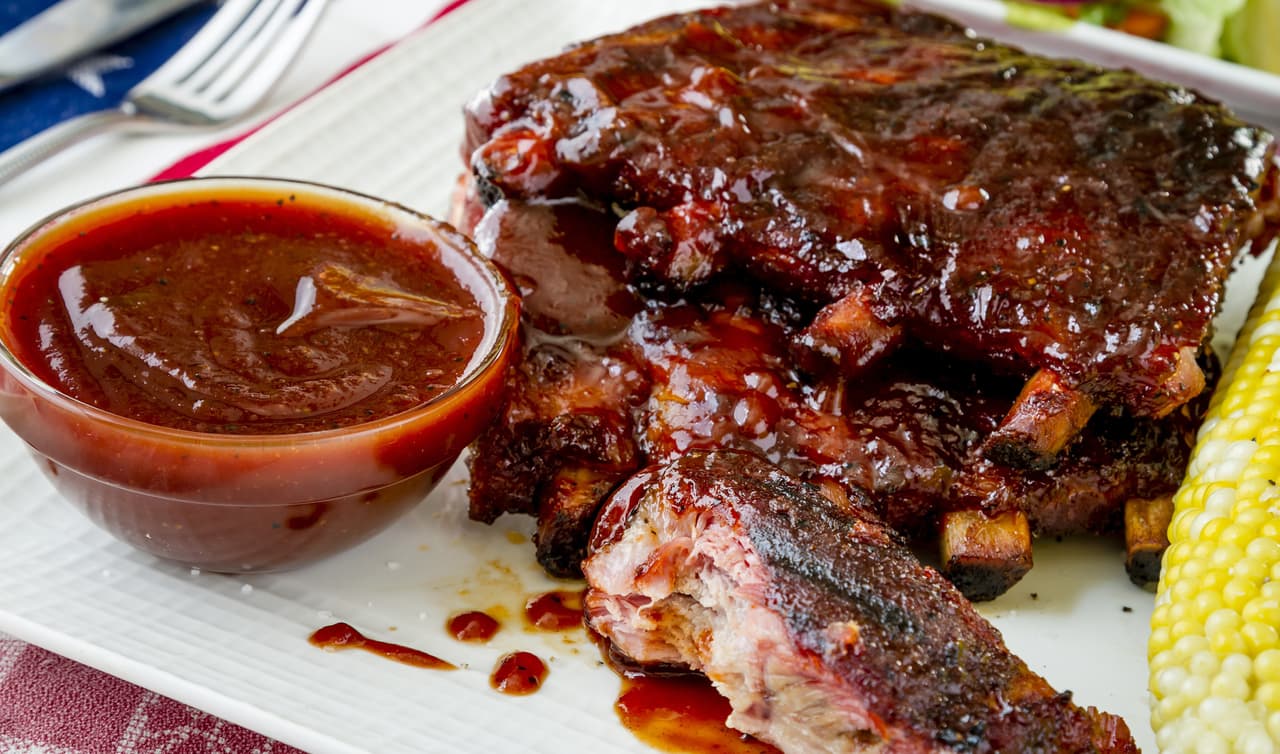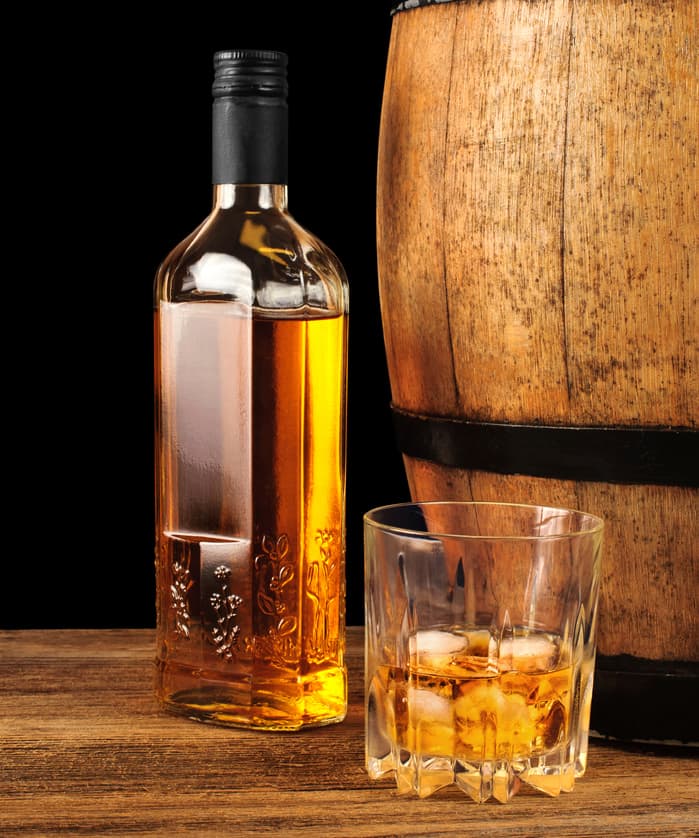CULINARY APPLICATIONS
creations
CULINARY

Bourbon adds premium value in savory prepared sauces. Photo courtesy of: Teri Virbickis/ Shutterstock
Bourbon secures its spot on the menu, in new product development.
What Can Brown Do For You?
As we move into fall, the cooler weather typically also brings a desire to seek deeper, more complex, and warm flavors in our beverages and food. And nothing goes quite as well with changing leaves, football and gatherings around the firepit—than bourbon. Whether over the rocks or incorporated into a savory or sweet dish, bourbon is a go-to flavor of fall.
According to the Distilled Spirits Council of the United States, more than 28 million 9-liter cases of bourbon were sold in the US in 2020, generating over $4.3 billion in revenue. Premium bourbon sales rose 46.1% over 2019 and super premium bourbons experienced 121% growth.
Bourbon-flavored dishes are often associated with comfort food and also one of the reasons it has experienced continued and growing popularity. It has warm, deep, caramel and vanilla flavors that provide the soothing comfort that consumers are seeking. Bourbon drinkers are willing to explore their favorite spirit and experience bourbon in new ways, and this leads to more inclusion of bourbon on the plate.
By JULIET GREENE, Contributing Editor


According to Datassential 2021 research, bourbon on the menu is up 148% in mentions since 2010. From QSR to Fine Dining, in chains and independent restaurants, bourbon is the leading spirit found in new menu items.
The Savory Side
According to Datassential 2021 research, bourbon on the menu is up 148% in mentions since 2010. From QSR to Fine Dining, in chains and in independent restaurants, bourbon is the leading spirit found in menu items. At Wendy’s, consumers can order the popular bourbon bacon cheeseburger, and Church’s Chicken features a Bourbon Black Pepper Smokehouse Chicken Sandwich.
For savory applications, chefs find that bourbon makes a great base for sauces and marinades across all industry categories, including retail and QSR. Bourbon’s sweetness pairs perfectly with smoky and spicy notes, so it can be used with smoked meats – think bacon – and is suitable for BBQ and smoking. When using bourbon in product development, food innovators will have to either build on top of the spirit flavor, deglaze to build flavor into the bottom notes or freshen in the end. If too much bourbon is used, the item will become top heavy. If using a covered kettle, manufacturers can flash off the alcohol without losing too much of the flavor.
BBQ restaurants and sauce manufacturers have embraced bourbon, as BBQ proteins with a sweet, smoky flavor are the perfect combination for bourbon infusion. Some popular applications include bourbon glaze with smoked bacon, and a bourbon honey glaze with chili powder for a delicious salmon, red meat or pork dish. Bourbon paired with brown sugar and apple cider vinegar hits all the right savory and sweet notes to use as a marinade. For a little zing, a chipotle and bourbon pairing elevates a dish because the smokiness of the pepper enhances the smokiness of the bourbon.

Bourbon drinkers are willing to explore their favorite spirit and experience bourbon in new ways, and this leads to more inclusion of bourbon on more menus and in many more new products. Photo courtesy of: Mizkan America Inc.

Bourbon paired with any stone fruit application is always a great flavor combination. Photo courtesy of: Mizkan America Inc.
The Sweeter Side of Bourbon
On the sweeter side, manufacturers have found the natural connection between bourbon and desserts. Boozy ice creams and desserts, including the Vanilla Bourbon Toffee Scooped ice cream from Carvel Ice Cream, are growing in popularity with consumers.
Bourbon pairs well with sweet applications because the vanilla and other nuances from the aged oak barrels come out in bourbon. The flavors are versatile with sweet and nut applications, such as ice creams, custards, pie fillings, poached or sous-vide fruits, preserves and glazed nuts. Bourbon paired with any stone fruit application is always a great flavor combination.
Recipe Development
Recipe developers can use bourbon to complement and enhance the formulation of a product, while not overwhelming the final product. If the final product has bourbon in it, the consumer expects to taste that spirit. The percentage of alcohol that food processors use when producing foods made with alcohol can vary between 5% to 20%, and manufacturers should be wary to heat the spirits enough to remove the alcohol, but not lose the flavor of the spirit.
Depending on cooking methods and heat exchange systems, manufacturers can best decide whether to add the spirit at the beginning, middle or end of the cooking process. When producing large-scale food products, manufacturers should use an industrial spirit designed for large-scale production or otherwise risk the flavor profile of their product varying year to year.
Reductions and Denatured Bourbon
For recipe developers seeking to create a final product without alcohol content, a spirit reduction is an excellent ingredient choice. Reductions tend to impart a “cooked” flavor in a dish, adding complexity without the use of a flavor or cooking the final product.
If using a bourbon reduction, manufacturers should consider that it is not a direct replacement for bourbon, because reducing also removes some other higher alcohols that contribute to flavor. Even with a reduction, cooking does not remove 100% of the alcohol. There is always some residual amount that will decrease with cooking time. Manufacturers should consider using a bourbon reduction at a higher level to account for any flavor loss during alcohol removal.
Food innovators can directly replace traditional bourbon with denatured bourbon as long as they account for 3% salt in the recipe. The alcohol can act as a carrier and enhancer for the flavors and compounds that are not normally soluble in water.
Bourbon Pleases the Palate
Bourbon continues to be a leading spirit as a food ingredient, especially with BBQ sauces, marinades and the cooking sauce category. Bourbon is interesting to the palate because it has a complex intense flavor that is also fruity, caramelized, sweet, oaky and smooth with a long lasting finish. PF
Juliet Greene is a corporate chef for Mizkan America Inc. Based in Mount Prospect, Ill., Mizkan America Food Ingredients Division is a full-service supplier and works closely with research, development, procurement and logistics departments. Mizkan strives to meet all food ingredient and foodservice needs. To learn more, visit mizkan.com/food-ingredients/
September 2021
